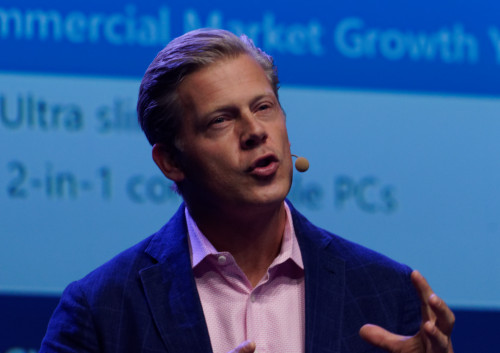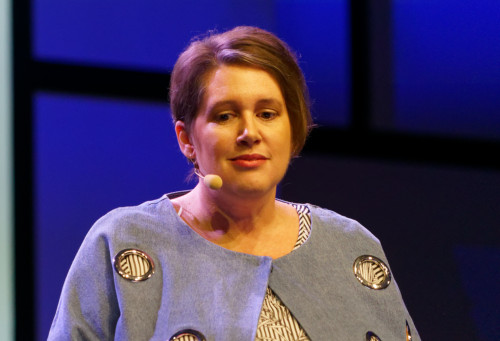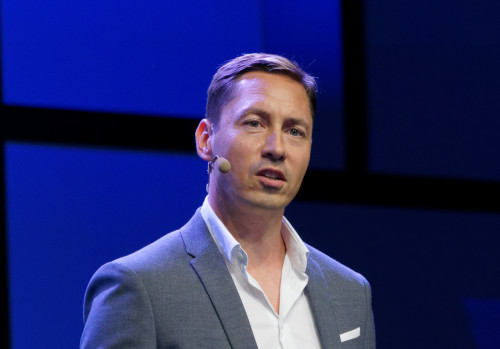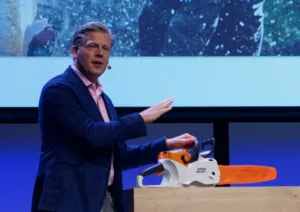Microsoft gave the second keynote of IFA and was represented by Nick Parker who is the VP responsible for consumer client devices at the firm. His talk started with the introduction video from IFA (also used for LG).
Heithecker, Executive Director of IFA came on to talk about how many different computers there are at IFA – not just the obvious PCs, but the many, many computers in other devices. Today, computing devices are connected and can use the cloud. However, most of us don’t notice them. Microsoft has been in many devices and Heithecker introduced Parker who showed another video of ‘edge devices’ talking to the cloud.
 Microsoft’s Nick Parker. Image:Meko
Microsoft’s Nick Parker. Image:Meko
Parker’s talk was entitled ‘The Intelligent Edge Opportunity’ and he started with some stats that showed growth in many areas including:
- Windows 10 has 700 million active devices and
- 300 million new Windows devices have been sold in FY 2018
- Windows 10 has seen 79% commercial PC growth in the last year
Looking ahead three years, there will be around 25 bilion connected devices and endpoints.
Parker said that privacy is a fundamental human right and that data should be for the benefit of the user. Second, the whole industry has to work together on cybersecurity. Third, AI can transform the world for good and, Parker said, we should ask not what computers can do, but what they should do.
Parker said that MS sees an intelligent cloud, with an intelligent edge and he talked about he and his family have different devices and different edge points. Microsoft wants to supply people-centred experiences that make life easier.
Going deeper, gaming can be played on consoles or on PCs. AI is not a nice to have, but a ‘must have’ and Microsoft wants to provide the building blocks of AI so that users can create their own AI. AI is already being used in Office and other tools such as Bing. Ubiquitous computing is being provided through Azure technology for the support of sensors, or in ‘PC class’ or in servers.
Yes, that’s an internet-connected chain saw! Image:Meko
There are many new connected devices. Stihl has a connected chainsaw that can allow tracking of location and usage. Genetec has a retail sensor that helps retailers to optimise the consumer experience. The Cheetah translator is a €59 device that runs on Azure IoT Edge. Next, Parker showed the Yoga Book 930 that has a haptic keyboard based on E Ink (see our separate article). (Lenovo Continues to Innovate)
Erin Chapple is a VP from the Windows business. The Windows group likes to support different ways of working and of achieving an objective. In the past, storage was usually local, but now storage is moving to the cloud. Windows 10 can identify files that haven’t been used and copy them to OneDrive. The interaction of the phone and PC is common, but the two worlds are separated. In Windows, text messages can be mirrored to the PC. The technique uses a trusted connection between the phone and the PC. Android notifications can also be shown in Windows.
 Erin Chapple is from the Microsoft Windows business. Image:Meko
Erin Chapple is from the Microsoft Windows business. Image:Meko
The app on the phone is called Microsoft Launcher and is available now and the app on the PC will be on the next version of Windows (October 2018 update)
Modern devices are powerful, thin and based on SSD and have Windows Hello, far-field mics and support for digital ink, Chapple said and she then showed a range of different partner systems:
- Ausu Vivobook Flip T401 – starts at $329
- Dell Inspiron 13 7000 – heat flows through the hinge and it uses the Whisky lake processor series
- The Acer Predator Triton 900 which has an ‘Ezel Arrow Hinge’ and has a 4K gaming display and XBox controller support
- The Microsoft Surface Go is a compact design that runs the full Office suite and there will be an LTE version available. Pricing for the Go starts at $399.
LTE used to be a ‘nice to have’ but is increasingly seen as a necessity. 4G and 5G will become the core of computing, Chapple believes. That will also change the way of working for individuals and teams. It also means that corporations and users may no longer have to maintain their own networks, and Microsoft expects the ‘Network as a Service’ to be a major development. At the moment, people trade security for convenience, but 5G should help with this.
Last year MS introduced Always Connected PCs based on Intel and Qualcomm processors and the company continues to invest in new technologies. The Lenovo C630 uses a Qualcomm Snapdragon processor. It has LTE connectivity and a pen. It has a fanless design and an integrated fingerprint sensor for security.
Getting connected is intended to be as easy as possible and the the company has been working on eSIM solutions for single users as well as corporates. Productivity can be improved allowing working anywhere and at any time.

Thomas Kowollik is GM of Consumer and Device Sales for Microsoft DACH. He highlighted some trends
- Subscription economy – such as Netflix, Spotify, Office 365 and XBox online gaming – based on connectivity and computing and needed because customers want to be future proof.
- IDC says that many PCs will be sold as ‘Device as a service’ (DAAS) both for corporates and for consumers. Kowollik said that it will reduce the cost of ownership.
Kowollik said that Also in Germany is working on dedicated hardware and software bundles for vertical applications. Synaxon is making things simple and HP, Dell and Lenovo are offering a range of support services for DAAS.
The intelligent edge devices are being shown at IFA by Microsoft, for the first time.

